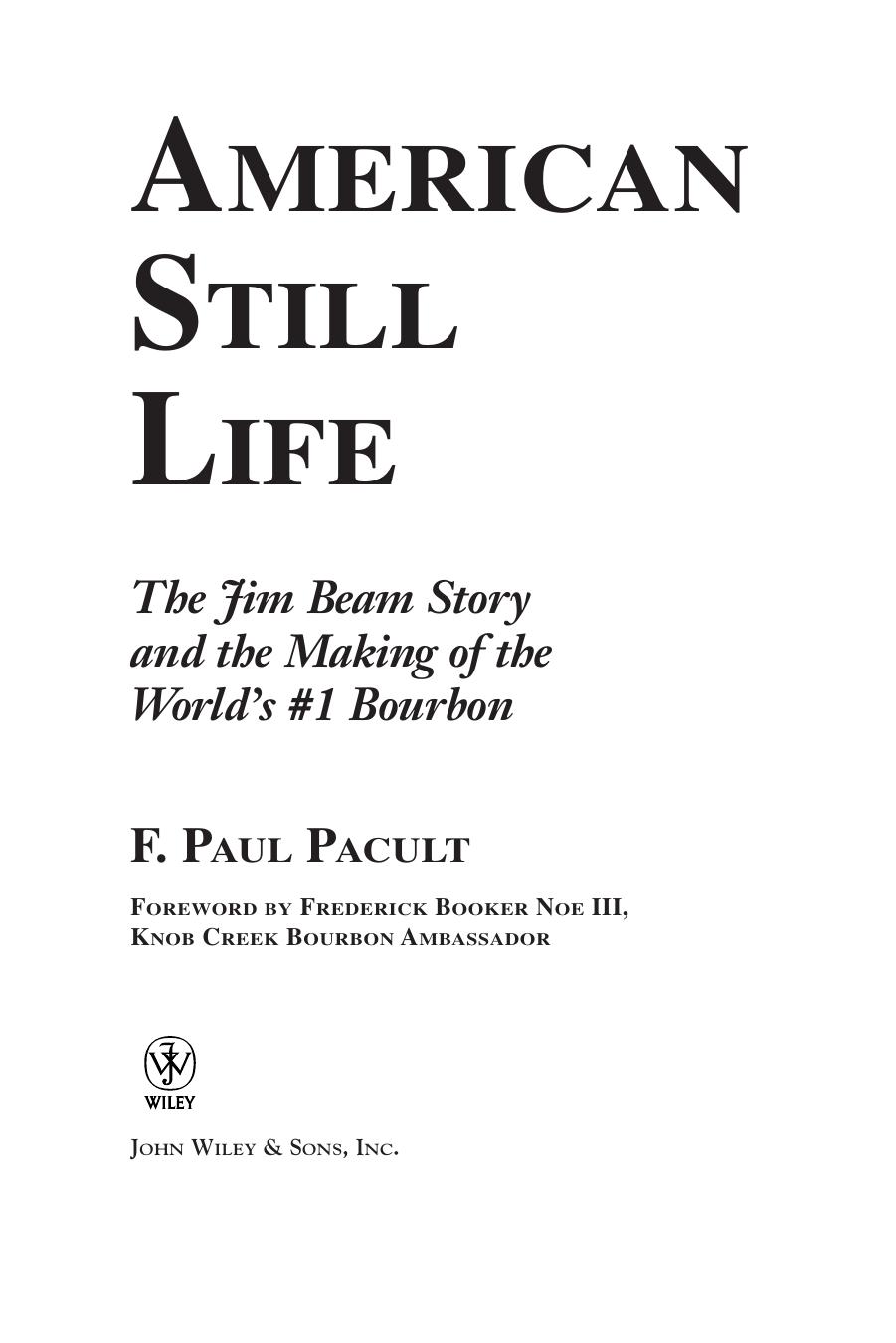American Still Life: The Jim Beam Story and the Making of the World's #1 Bourbon by F. Paul Pacult

Author:F. Paul Pacult
Language: eng
Format: mobi, pdf
Published: 0101-01-01T00:00:00+00:00
In 1941, Harry Homel and Oliver Jacobson sold their shares in the James B. Beam Distilling Company to Harry Blum, Phillip Blum's son, for around $1 million, making the Blums the sole proprietors. The internal sale was instigated from the outside when Schenley made an offer to buy the well-run and profitable James B. Beam Distilling Company. Negotiations turned sour and were terminated when Blum found out that Schenley had agreed to retain the services of Homel and Jacobson, but not Blum. Though Blum wouldn't have wanted to go over to Schenley anyway, he was offended enough to quash the deal and purchase the one-third interests of his partners.
While Jim Beam with some reluctance transferred the bulk of the day-to-day operations of James B. Beam Distilling Company to T. Jeremiah and Park's boys by the early 1940s, he remained the primal force behind the scenes, needing by nature to keep his hand stirring the pot. Jim's brother Park retired from James B. Beam Distilling Company in 1943, passing the distilling torch to his able sons Earl and Carl. Most accounts imply that Jim sorely missed Park when he left to consult at Shawhan Distillery.
One commonly told story describes Jim's concern with the protection of the all-important family recipe for yeast and the unique strain that he himself developed in 1934. Yeast, if you recall, is the biochemical trigger for the fermentation of the grain mash. Each individual yeast culture imparts a singular flavor to the whiskey and is therefore deemed to be of vital importance to distillers. Even a minor variation in the culture could alter the taste of the bourbon whiskey. Always concerned that a disaster might befall the distillery after it shut down for the workweek, Jim would assiduously take home a portion of the yeast culture in a sealed jar to protect it from any unforeseen weekend calamity. Every Friday evening like clockwork Big B would be observed by his neighbors and friends driving his black Cadillac from Clermont to his big home on Distillers Row in Bardstown, the jar of yeast nestled safely in the front passenger seat beside him.
That simple tale as well as any illustrates the enduring character of Jim Beam even in his twilight years: attentive to detail, personally immersed in the grand as well as the mundane, and, most of all, fully mindful of the Beam family legacy. Perhaps the horror of Prohibition or the advancement of age had made Jim an especially cautious septuagenarian. What is clear is that Jim Beam like his father, grandfather, and great-grandfather took nothing in life for granted.
War had been brought to America's doorstep and the distilling industry was expected to do its part in the national war effort. The distillers of Kentucky pitched in by producing industrial alcohol, a fundamental compound required for a myriad of wartime necessities. In The Book of Bourbon and Other Fine American Whiskeys (1995, p. 84), authors Gary and Mardee Haidin Regan document the variety of wartime goods in which industrial alcohol was a critical element.
Download
American Still Life: The Jim Beam Story and the Making of the World's #1 Bourbon by F. Paul Pacult.pdf
This site does not store any files on its server. We only index and link to content provided by other sites. Please contact the content providers to delete copyright contents if any and email us, we'll remove relevant links or contents immediately.
Life 3.0: Being Human in the Age of Artificial Intelligence by Tegmark Max(5476)
The Sports Rules Book by Human Kinetics(4296)
The Age of Surveillance Capitalism by Shoshana Zuboff(4214)
ACT Math For Dummies by Zegarelli Mark(3996)
Unlabel: Selling You Without Selling Out by Marc Ecko(3591)
Blood, Sweat, and Pixels by Jason Schreier(3566)
Hidden Persuasion: 33 psychological influence techniques in advertising by Marc Andrews & Matthijs van Leeuwen & Rick van Baaren(3474)
The Pixar Touch by David A. Price(3366)
Bad Pharma by Ben Goldacre(3357)
Urban Outlaw by Magnus Walker(3342)
Project Animal Farm: An Accidental Journey into the Secret World of Farming and the Truth About Our Food by Sonia Faruqi(3178)
Kitchen confidential by Anthony Bourdain(3014)
Brotopia by Emily Chang(3001)
Slugfest by Reed Tucker(2943)
The Content Trap by Bharat Anand(2863)
The Airbnb Story by Leigh Gallagher(2800)
Coffee for One by KJ Fallon(2569)
Smuggler's Cove: Exotic Cocktails, Rum, and the Cult of Tiki by Martin Cate & Rebecca Cate(2473)
Beer is proof God loves us by Charles W. Bamforth(2375)
